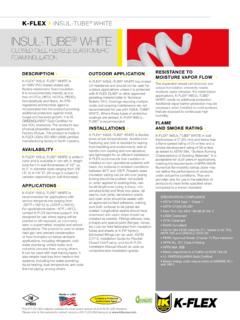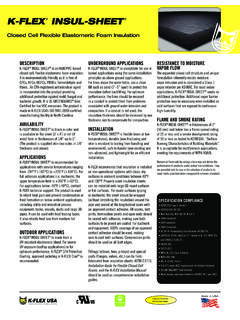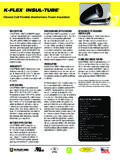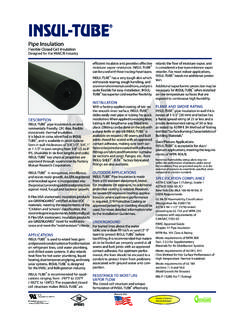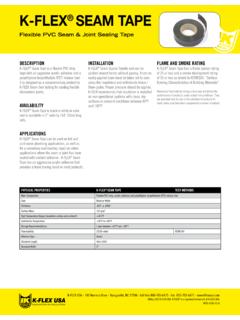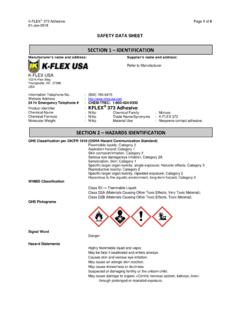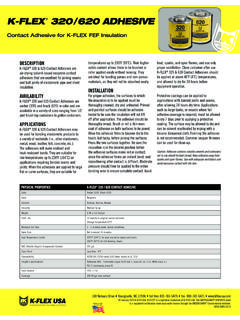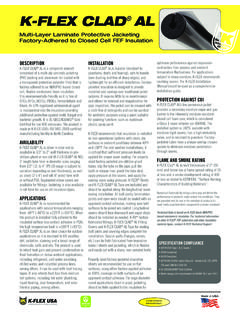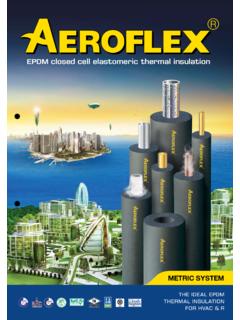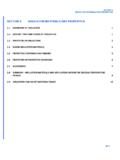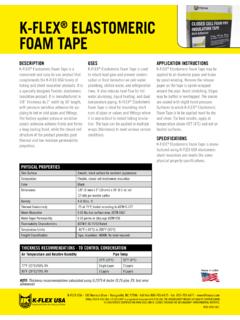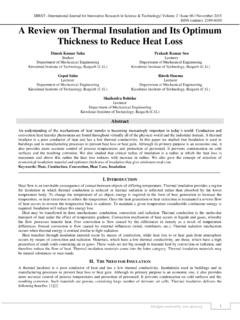Transcription of Ammonia - K-FLEX USA
1 Ammonia Prod u c t p e r f o rmance for insulation of a m monia piping ABOUT K-FLEX USA. K-FLEX USA IS A LEADING MANUFACTURER In April 2012, K-FLEX USA was awarded of closed cell flexible elastomeric foam with ISO 9001:2008 certification by FM. insulation products for mechanical piping, Approvals. The independent certification air handling units and vessels. demonstrates the company's commitment to quality. Designed for ease of installation and reliable performance, K-FLEX products K-FLEX products have proven performance provide excellent thermal and acoustical in the Plumbing, HVAC/R, Commercial/. performance, including inherent resistance Industrial, Marine, Oil & Gas, Acoustic and Youngsville, NC Headquarters to moisture intrusion.
2 OEM Markets. K-FLEX USA prides itself on being respon- As a member of the IK insulation Group, sive to the market, providing dependable K-FLEX USA delivers state-of-the-art levels service to customers throughout North of technical knowledge and customer sup- America, bringing an innovative approach port to the global mechanical insulation to product offerings, and having products market. that are 3rd party tested and certified. COMPANY HISTORY 2001. Nomaco insulation 2004. and L'Isolante K-FLEX NKF acquires RBX's mechanical 1989 join to form Nomaco 1965 L'Isolante K-FLEX was insulation business. Rubatex was formed. K-FLEX (NKF). formed. 1999 2008. 1975 Rubatex acquires 2002 Jan. 10, 2008. Halstead was formed and Halstead to form NKF enters into a L'Isolante K-FLEX re- INSUL-TUBE became a well- RBX Industries.
3 Sales and Marketing deems Nomaco shares known product brand. Agreement with RBX in NKF and goes to Industries. market as K-FLEX USA. K-FLEX USA BENEFITS GLOBAL PRESENCE. Designed for lasting performance: L'ISOLANTE K-FLEX : K-Value: @ 75 F & Permeability: perm-in 11 production facilities worldwide Responsive to market Commercial distribution in 43 countries Industry & Product expertise Headquartered in Italy 3rd Party Certified Products Broad size range: 25/50-rated up to 2 thick Systems Approach Factory-applied PSA & Cladding Full line of accessories 2. insulation SELECTION. Critical Factors to Consider Proper Material Selection, Thickness, Installation & Maintenance =. Energy Savings Eliminate Refrigerant ( Ammonia ) Leakage Condensation Control Moisture Intrusion & Ice Formation Prevention Improved Equipment Performance Minimize Corrosion Mold / Mildew Resistance Personnel Safety Process Control Meets Fire Codes Cost efficiency Cost to remove a failed system = 3-5 times initial cost of installation + additional costs of downtime & mold removal.
4 Application Considerations Extreme below-ambient conditions (-50 F to 40 F process) --> vapor drive. Vapor retarder High level of moisture vapor pressure in ambient air trying to get to air surrounding the insulated pipe surface where moisture vapor pressure is much lower. insulation Unidirectional --> steadily drives against insulation . Magnified when the system operates continuously in cold mode and in high humidity Vapor pressure conditions. Cold pipe Causes of insulation Failure Next to the issue of open seams, moisture vapor intrusion is the single-most destructive factor to insulation , with studies showing that for every 1% moisture gain, the insulation efficiency drops 7%. This gain takes place as moisture-laden air migrates through the insulation system to the pipe surface and forms moisture on the pipe.
5 The closed cell structure of the insulation is critical as moisture inevitably accumulates in permeable insulation even with a concentrated vapor retarder jacket. The presence of job site abuse and improper installation means there is additional risk involved with permeable insulation products, which rely on jacketing to serve as a vapor retarder. Wet insulation and mold growth on the outer surface of the system (pictured right) are indicators that the insulation has failed. 3. insulation OPTIONS. The purpose of these technical notes is to of insulating Ammonia systems. For an (table 1) and to the key properties of the offer designers and those working in the understanding of the analysis carried out, different insulation options in table 2.
6 Field a thorough overview of insulation we will refer both to the most commonly materials commonly used for the purpose used materials for Ammonia applications Table 1. A K-FLEX closed cell elastomeric foam B CELLULAR GLASS. C Polystyrene D Polyisocyanurate (PIR). Table 2. TECHNICAL PROPERTIES. K-FLEX closed Cellular Polysty- Polyisocya- Cell Elatomeric Glass rene nurate (PIR). Thermal k (75 F mean) Water Vapor Permeability < without jacketing (perm-in). Service Temperature ( F) -297 F to +220 F -450 F to -65 F to -297 F to +800 F +165 F +300 F. Density (pcf) 3 - 4 - closed Cell Structure Yes Yes Yes 90%. Flexible Yes No (Fragile) No No ASTM E84 25/50 Yes Yes No No flame rating (2 ). Self-seal closure option Yes No No No Thermoplastic No No Yes Yes (Highly combustible, may melt, drip or carry a progressive flame).
7 4. Water Vapor Permeability As indicated by the detrimental effects to reach areas where the temperature chart below shows the permeability values of water vapor intrusion, the water vapor is low enough to form condensation, for commonly used insulation materials permeability of an insulation material is a even if the surface temperature of the in Ammonia applications. As the chart critical component of its performance. If insulation is high enough to prevent indicates, elastomeric and cellular glass the insulation material is vapor permeable, surface condensation. An insulation are the only two unjacketed materials that as indicated by a high permeability value, material with low permeability would are classified as Class 1 vapor retarders moisture can move through the insulation prevent this situation from occuring.
8 The as defined by ASHRAE. Permeability Comparison K-FLEX closed CELL ELASTOMERIC FOAM. Cellular Glass Polystyrene Polyisocyanurate (PIR). ASHRAE Class 3. - ASHRAE Class 2. - Permeability (perm-in). ASHRAE vapor retarder classes Class 1: perm or less Class 2: perm or less Class 3: 10 perm or less ASHRAE Class 1. < Cellular Polyisocyanurate Polystyrene K-FLEX . Glass (PIR) Elastomeric Permeability (perm-in). Cellular Glass* Polyisocyanurate (PIR)* Polystyrene* K-FLEX Elastomeric < * Taken from manufacturer's published data. 5. Water Vapor Permeability A further analysis of the importance of Additionally, elastomeric closed cell concentrated moisture vapor barrier an insulation material's permeability is insulation materials have an established (jacket) for protection against moisture illustrated below.
9 History of successful use as an insulation intrusion. material for cryogenic applications (see K-FLEX insulation 's closed cell structure Project Experience on page 11). If the barrier is damaged (even a pinhole). and low permeability inherently resists or the edges are not properly sealed, they moisture, providing distributed resistance In contrast, closed cell materials with a are susceptible to moisture intrusion and against moisture vapor intrusion without high permeability ( polystyrene and subsequent energy loss or mold growth. the need of a jacket. polyisocyanurate) are not inherently Once moisture penetrates, it can wick and resistant to moisture and rely on a involve large areas in the mold growth and energy loss process.
10 Performance Comparison Warm Air High wvt: requires concentrated Vapor Retarder Jacket Condensation formation resulting in ice build-up Cold Vapor Drive Line Low wvt ( K-FLEX <.01 perm-in): Inherent Vapor Retarder: Distributed Resistance 6. MOISTURE GAIN & THERMAL k Thermal k performance over time with moisture gain (10 years). The effect of moisture gain on thermal permeability of the insulation is less than Conditions: Ambient 90 F Pipe 40 F . k after 10 years is shown below. The perm-in, there will be minimal long- Relative Humidity 85% Pipe Size 4 . data leads to the conclusion that on term effects on the k-value. insulation Thickness 2 wvt drive exists most below-ambient systems, if the 50% of the year 1.
